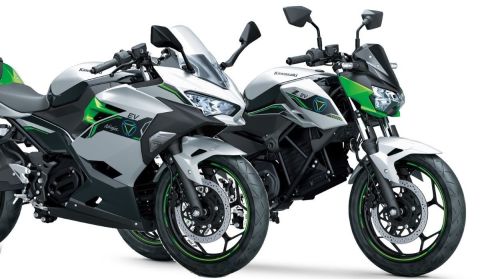A quick look at Kawasaki's latest e-motorcycles: Ninja e-1 & Z e-1
Beckoning a pivotal leap towards motorcycling’s electrifying future, renowned brand Kawasaki has recently unveiled the Ninja e-1 and Z e-1 models, which are expected to enter the US and European markets sooner than later.
The Kawasaki Ninja e-1 and Z e-1 showcase the brand’s deliberate foray into the realm of electrification, while also pointing to the company’s measured approach to adding electric two-wheelers to its ever-growing lineup. Amidst Japan’s big four, Kawasaki has emerged as the pioneer, being the first to launch a full-sized battery-powered motorcycle to the market ahead of rivals like Honda, Suzuki and Yamaha.
In spite of the innovative drivetrain, both e-motorbikes have retained much of the essence and familiarity of their internal combustion engine (ICE) predecessors, at least when they are in stationary positions.
While the company hasn’t yet offered test rides, the two new electric models avoid the futuristic design cues that are commonly seen in other electric motorcycles available in the market. In other words, Kawasaki has opted for a more recognizable and traditional appearance.
When it comes to specs and performance, the new electric models of Kawasaki sport smaller electric motors and batteries, resulting in a performance closer to that of a 125cc-equivalent commuter bike. Both models share a 5-kW electric motor that is capable of producing a peak power of 9-kW, which roughly equates to 12 horsepower (hp) at full throttle. Obviously, these figures are not enough to meet the expectations of ardent fans, and these models lack the sheer dynamism of their ICE counterparts.
Equipped with two riding modes, Eco and Road, and a boost button for temporary power augmentation, the new electric models offer varying speeds. Eco mode peaks at 40 mph (64 km/h), however it can reach 47 mph (76 km/h) with the help of the boost button, while the Road mode sustains speeds up to 55 mph (88 km/h), extendable to 65 mph (105 km/h) with the help of the boost button. It may be noted here that the boost button can be used for just 15 seconds.
Scheduled to enter the American and European markets in the near future, both the Kawasaki Ninja e-1 and Z e-1 will be available for purchase through existing dealers of the brand. The much-anticipated pricing details have also been announced, with the Ninja e-1 priced at $7,599 and the Z e-1 starting at a slightly lower $7,299 for the US market.
